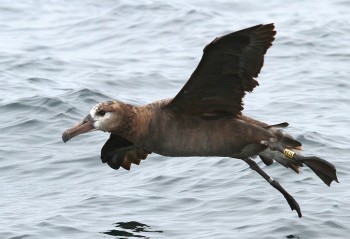The globally Near Threatened Black-footed Albatross Phoebastria nigripes is a non-breeding visitor to Canada’s Pacific waters, where it is at risk to mortalities caused by longline fishing. The albatross was listed as a species of Special Concern ("species at risk of becoming threatened or endangered"; roughly equivalent to a status of Near Threatened) by Canada in 2007 (click here).
A final management plan has now been produced for the Black-footed Albatross in Canadian waters.
The plan’s executive summary follows:
“The Black-footed Albatross is a long-lived seabird that breeds mainly in the Northwestern Hawaiian Islands and occurs at sea off the Pacific Coast of Canada during the breeding and non-breeding seasons. Significant numbers feed off the coast of British Columbia each year, including adults making long foraging trips to feed their young.
The population seems generally stable, but relatively high numbers are caught as bycatch in longline fisheries in the North Pacific. Additionally, adults and immature birds are affected by the accumulation of toxic chemicals and heavy metals and by the ingestion of waste plastics from the surface of the sea when they are feeding. Because of the unknown effect of these particular threats over the long term, the Black-footed Albatross has been listed as a species of Special Concern in Canada. Emerging threats such as the potential loss of nesting and foraging habitat due to climate change also threaten this species.
The management objective for the Black-footed Albatross is to “...help to increase global population numbers and maintain the population throughout its documented distribution in Canadian waters, by reducing at-sea mortality and otherwise augmenting international conservation efforts.” The conservation of the Black-footed Albatross cannot succeed by Canadian efforts alone due to the wide-ranging marine nature and distant nesting habitats of this species.
Actions already underway include long-term at-sea surveys that record Black-footed Albatross distribution and abundance in Canada, and assessments of longline bycatch mortality in Canadian Pacific waters, including monitoring of current bycatch levels. Bycatch mitigation measures have been implemented in the target fishing fleet, but monitoring for compliance and effectiveness is limited and should be increased. Strategies and measures to achieve the management objectives are presented in the section entitled Broad Strategies and Conservation Measures.”
Click here for an earlier report on the management plan in ACAP Latest News.

A colour-banded Black-footed Albatross at sea, photograph by Vicki Miller
With thanks to Ken Morgan.
Reference:
Environment and Climate Change Canada. 2017. Management Plan for the Black-footed Albatross (Phoebastria nigripes) in Canada. Species at Risk Act Management Plan Series. Ottawa: Environment and Climate Change Canada. iv + 30 pp.
Click here for the French text.
John Cooper, ACAP Information Officer, 08 January 2018

 English
English  Français
Français  Español
Español